
TIRE CARE & KNOWLEDGE
The ultimate tire maintenance guide: proven techniques for ensuring maximum tire performance and safety.
BASIC TIRE KNOWLEDGE
A starting point to answer your questions about tires. Discover everything from how to read your sidewall to how your tires can carry your whole vehicle.
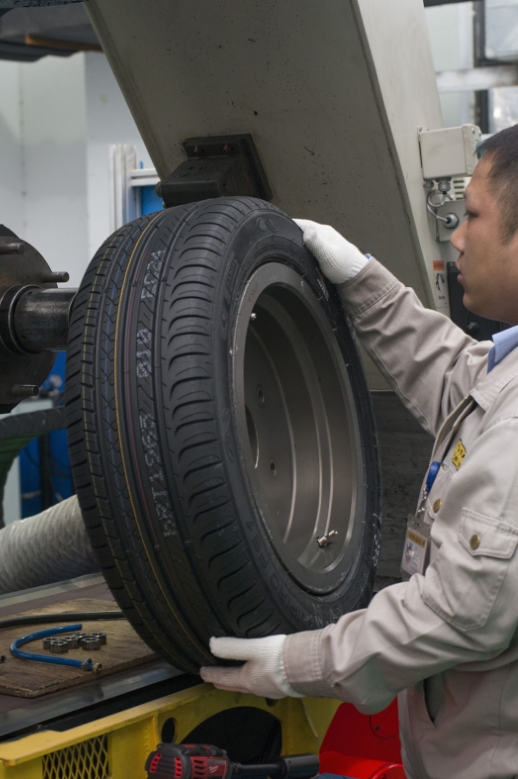
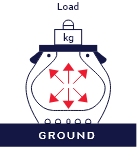
Load
The contact area of each tire is equivalent to the size of a hand but it can carry the weight of the vehicle and its passengers.
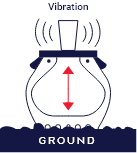
Shock Absorption
When driving on unpaved roads, do you know what ensures a comfortable drive? Tires! Tires are formulated using 50% elastic rubber with inner air pressure serving as a shock absorption tool to help minimize bumpy rides.
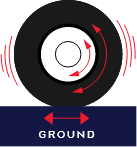
Vehicle Handling, Driving Force, and Braking Power
Tires are the only part of the vehicle that comes into contact with the road. When initiating, driving, braking, or parking your vehicle tires successfully help complete your command.

Steering Wheel Movement
Tires communicate the controls of the driver. Steering and reversing operations are dictated by the tires.
The sidewall provides valuable information about the tire including the specifications, the brand, and the type of construction. All numbers are standardized and recognized by tire manufacturers around the world.
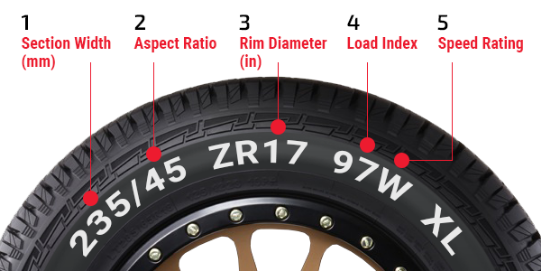
Codes:
- Section Width(mm)
- Aspect Ratio(Section height as a percentage of the section width).
- Rim Diameter(in)
- Load Index
- Speed Rating
Load Index and Speed Rating
Load index corresponds to the load capacity while speed rating is designated using letters from J to Z and represents the maximum speed of the tire. These two factors are interdependent. Please refer to the tables below for the load index and speed rating.
Load Index (Maximum Load)
| LI | lbs | kg |
|---|---|---|
| 71 | 761 | 345 |
| 72 | 783 | 355 |
| 73 | 805 | 365 |
| 74 | 827 | 375 |
| 75 | 853 | 387 |
| 76 | 882 | 400 |
| 77 | 908 | 412 |
| 78 | 937 | 425 |
| 79 | 963 | 437 |
| 80 | 992 | 450 |
| LI | lbs | kg |
|---|---|---|
| 71 | 761 | 345 |
| 72 | 783 | 355 |
| 73 | 805 | 365 |
| 74 | 827 | 375 |
| 75 | 853 | 387 |
| 76 | 882 | 400 |
| 77 | 908 | 412 |
| 78 | 937 | 425 |
| 79 | 963 | 437 |
| 80 | 992 | 450 |
| LI | lbs | kg |
|---|---|---|
| 71 | 761 | 345 |
| 72 | 783 | 355 |
| 73 | 805 | 365 |
| 74 | 827 | 375 |
| 75 | 853 | 387 |
| 76 | 882 | 400 |
| 77 | 908 | 412 |
| 78 | 937 | 425 |
| 79 | 963 | 437 |
| 80 | 992 | 450 |
| LI | lbs | kg |
|---|---|---|
| 71 | 761 | 345 |
| 72 | 783 | 355 |
| 73 | 805 | 365 |
| 74 | 827 | 375 |
| 75 | 853 | 387 |
| 76 | 882 | 400 |
| 77 | 908 | 412 |
| 78 | 937 | 425 |
| 79 | 963 | 437 |
| 80 | 992 | 450 |
Speed Rating (Maximum Speed)
| J | K | L | M | N | P | Q | R | S | T | H | V | W | Y | |
|---|---|---|---|---|---|---|---|---|---|---|---|---|---|---|
| mph | 62 | 68 | 75 | 81 | 87 | 93 | 100 | 106 | 113 | 118 | 130 | 150 | 168 | 188 |
| 72 | 100 | 110 | 120 | 130 | 140 | 150 | 160 | 170 | 180 | 190 | 210 | 240 | 270 | 300 |
Run flat tires also known as safe tires or zero pressure tires are designed to perform after a puncture or complete loss of tire inflation pressure has occurred. These tires allow you to drive up to 80km at 80km/h to help you reach a safe place.
Comparison between Run Flat Tires and Ordinary Tires:
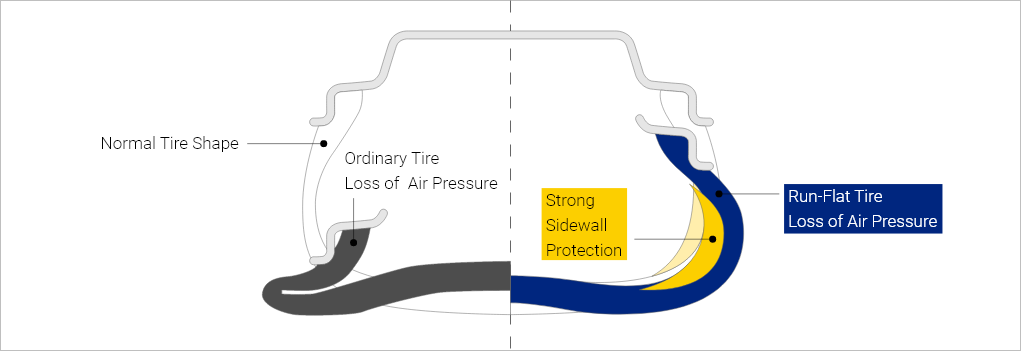
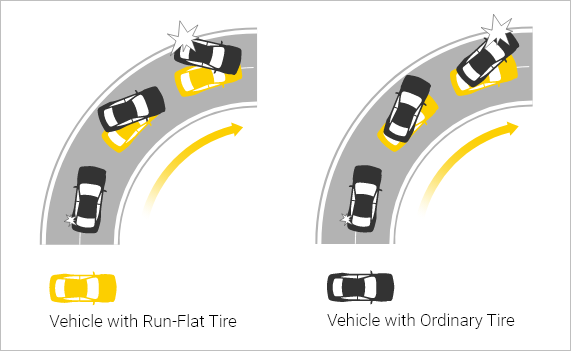
BLAZING SUN
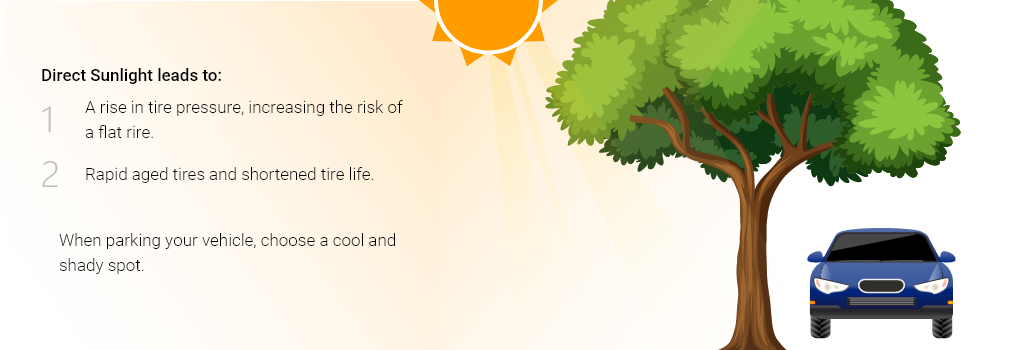
THUNDERSTORMS
Summer thunderstorms produce water on road surfaces and causes tire skidding.

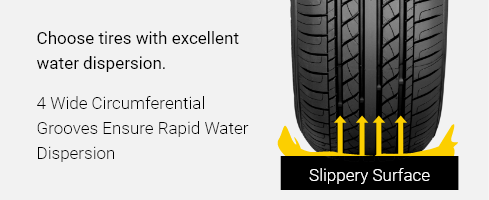
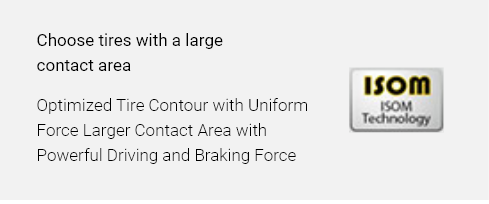
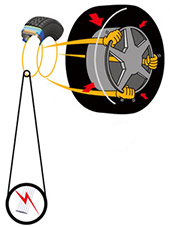
- 1
- 2
- 3
- When driving on unpaved roads, do you know what ensures a comfortable drive? Tires! Tires are formulated using 50% elastic rubber with inner air pressure serving as a shock absorption tool to help minimize bumpy rides.
- When a partial amount of pressure is applied, the strong bead ring can withstand up to 3 tons before it detaches from the tire.
- It will take more than 6 tons of force to break the bead ring.
When driving on unpaved roads, do you know what ensures a comfortable drive? Tires! Tires are formulated using 50% elastic rubber with inner air pressure serving as a shock absorption tool to help minimize bumpy rides.
The tire valve is made of rubber and after long term usage it will deteriorate. Overtime, normal driving practices will exert pressure on the valve causing damage or wear. Although a tire valve is not expensive, it plays an important part in tire performance and safety.
Giti Tire recommends replacing tire valves whenever new tires are installed.
Tire valve helps maintain stable tire pressure by inflating or deflating the tire.
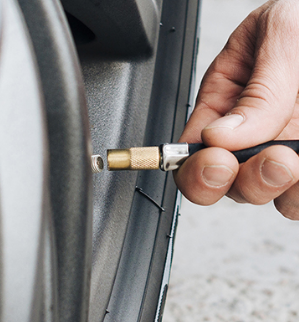

When treveling on the road, tires are the only part of the vehicle that comes into contact with the ground.

The contact area of each tire is equivalent to the size of a hand.

Carrying a weight of 2000kg.
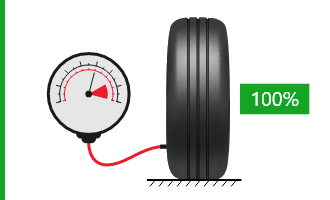
Proper Tire Pressure:
- Safer
- Durable
- Fuel-Efficient
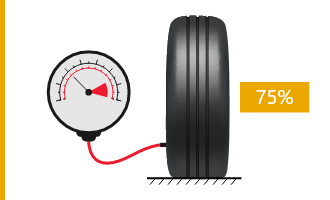
Improper Tire Pressure:
When air pressure is decreased by 25%, tire life is shortened by 20%
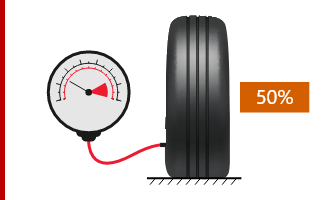

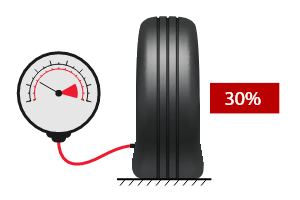
Danger Rapid of Air Leak:
- Fuel consumption is increased by a barrel each year
- Weaker handling and gripping power
- Breaking distance in wet road conditions increases by 9.5 meters (equivalent to the distance of two cars placed side by side.
EXTERIOR TIRE DAMAGE
Leads to air leaks, flat tires, shorter tire life, and affects safe travels.
Carefully check your tire's appearance. If problems appear, replace the tires immediately.



EXCESSIVE TREAD WEAR
Leads to reduced handling, braking, and water dispersion abilities
Measure the tread depth. If less than 1.6 mm, replace the tires immediately.
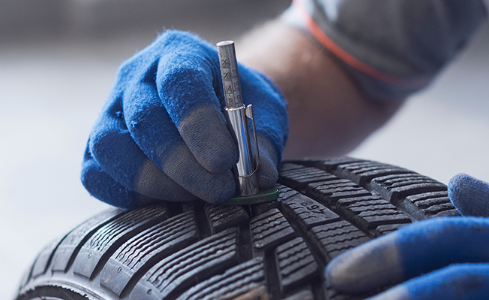
IMPROPER TIRE PRESSURE
Leads to uneven tire wear, reduced handling and comfort, increased fuel consumption, and even tire blowouts
Check the air pressure of all tires (including the spare). Standard tire pressure recommendations can be found in the owner's manual or on the driver side car door.
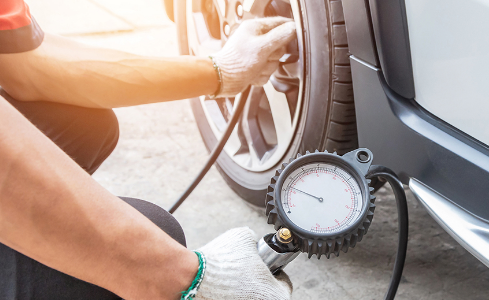
Selecting Suitable Tires for Different Road Conditions is Essential!
Friction Generated By Tire Pattern and Ground Is a Source of Power for Tires
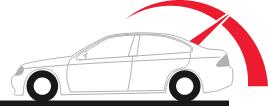
When you speed reaches
100km/h
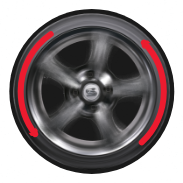
Your tire rolls
14 times per second
Every tire is designed with a tread wear indicator (TWI) which is a raised section molded into the grooves of a tire. In passenger car tires, the TWI is around 1.6 mm and the tire shoulder is labeled with TWI or the △ symbol.
TWI indicates the tread wear limit and helps vehicle owners understand the tread wear so they know when to replace the tires. When the tread is leveled with the TWI, the tread pattern will be separated and the tires need to be replaced immediately.
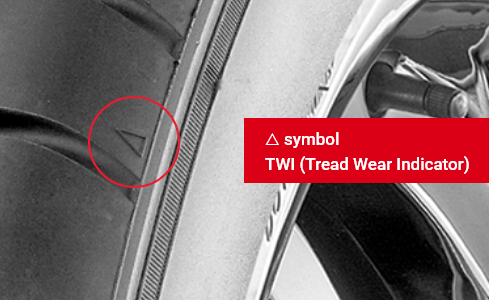
Note: When tread wear limit is reached, handling, braking, and water evacuation will significantly be decreased. Extremely dangerous!
Replace Tires Immediately If:
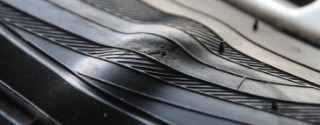
Sidewall Bulges
Please replace tires immediately to avoid tire blowouts
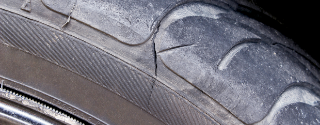
Multiple Cuts
Increases probability of tire leak.
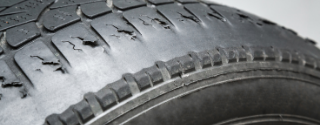
Sidewall Cracks
Tire shows signs of deterioration
If your tires have any of the conditions mentioned above, it is recommended that you visit the nearest Giti Professional Service Center to replace the tires!
The sidewall of a tire contains information for your safety and knowledge. Being able to read sidewall markings will help you better understand the performance of each tire and provide information for mounting and servicing the tire.

Codes:
- Section Width(mm)
- Aspect Ratio(Section height as a percentage of the section width).
- Rim Diameter(in)
- Load Index
- Speed Rating
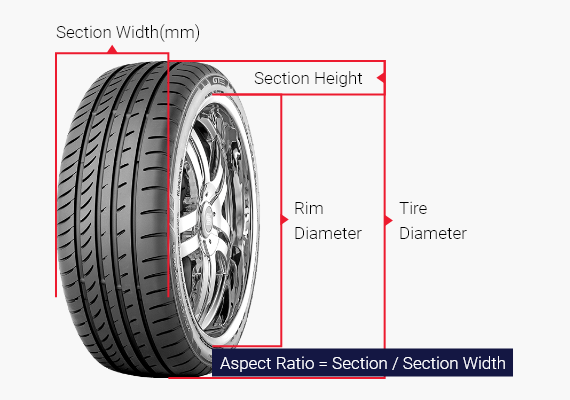
Passenger Car Tire Specifications: (195/60R15 88V)
- 235: Section Width (mm)
- 45: Aspect Ratio
- ZR: Speed Rating
- 17: Rim Diameter (in)
- 97W: Load Index and Speed Rating
Under specified conditions, speed rating is a letter representing the maximum speed at which the tire can carry a load corresponding to its load index (except for passenger car and motorcycle tires with speeds greater than 210 km/h).
Under specified conditions, load index is a numerical code representing the maximum load the tire can carry corresponding to its speed rating (except for passenger car and motorcycle tires with speeds greater than 210 km/h).
Speed rating is represented with a letter from J to Z and is the maximum speed corresponding to its load index.
Please refer to the following speed rating table (Maximum Speed).
| J | K | L | M | N | P | Q | R | S | T | H | V | W | Y | |
|---|---|---|---|---|---|---|---|---|---|---|---|---|---|---|
| mph | 62 | 68 | 75 | 81 | 87 | 93 | 100 | 106 | 113 | 118 | 130 | 150 | 168 | 188 |
| kmh | 100 | 110 | 120 | 130 | 140 | 150 | 160 | 170 | 180 | 190 | 210 | 240 | 270 | 300 |
TIRE MAINTENANCE
Tires require your care to perform at their best. Learn about tire mounting, rotations, balancing, and much more to keep your tires safe and driving well.
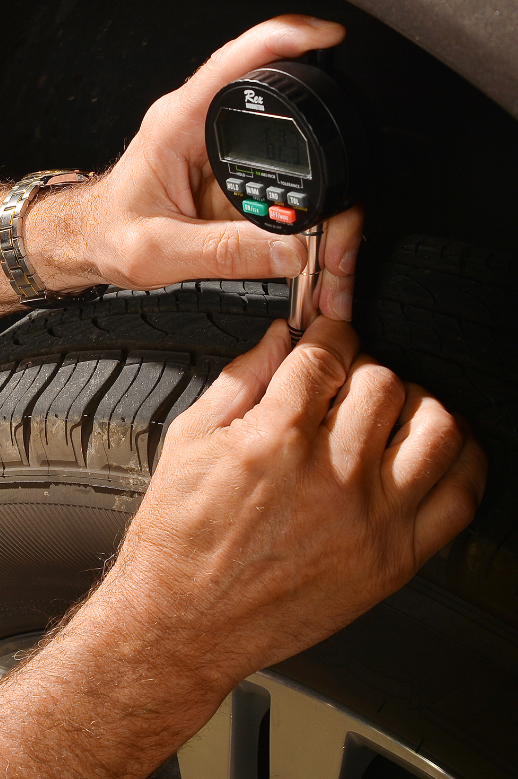

Maintenance Services
Measure and Adjust Tire Pressure

Maintenance Period
2 months or abnormalities
When to replace your tires
Every tire has a Tread Wear Indicator (TWI), which form a triangle TWI located on the sidewall. TWI is an indicator of tire wear and is also a benchmark to you to check if your tire is worn out. Tires should be changed immediately when the tire tread has surpassed the indicators.
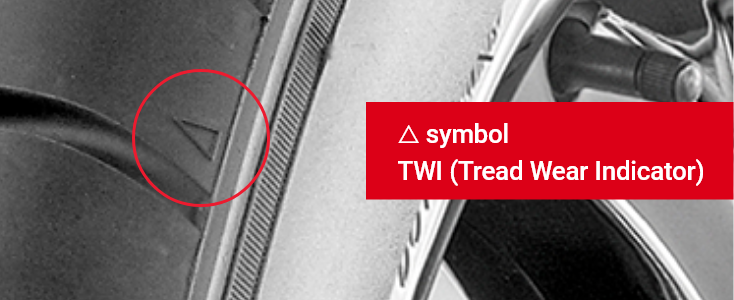
Worn out tires compromises handling and braking distance tremendously.
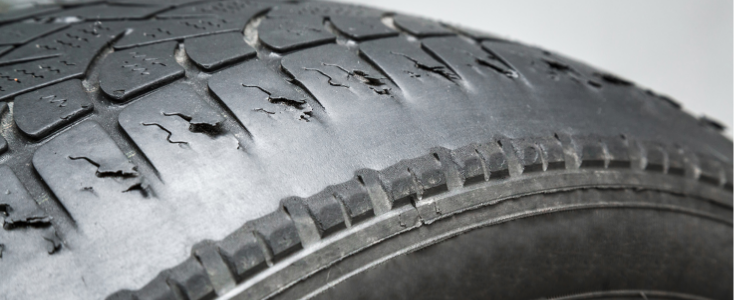
Do keep lookout for physical signs stated below, even if the tires have not worn out yet.
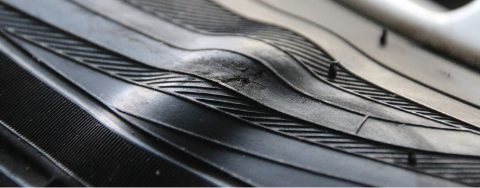
Bulges on tires
We recommend you to replace the tires immediately, due to high potential of tires bursting
A sign of potential air leak

Cracks
Normally on the tire`s sidewall
10 TIPS TO HELP YOU SAVE GAS AND MONEY
Get the most mileage out of each gallon of gas by following these simple fuel saving tips.
1. Proper Tire Pressure
When comparing tires that bear the same load, insufficient tire pressure causes high deflection and increases fuel consumption.
Connection between Tire Pressure and Fuel Consumption:
|
Pressure |
Consumption |
|
|---|---|---|
| 10% | 2% | 15% |
| 20% | 4.5% | 28% |
| 30% | 6.25% | 37% |
2. Optimize Octane
Most drivers mistake premium fuel as the best choice for the vehicle. Check the owner’s manual for the correct octane level for your engine. Around 20% of drivers purchase premium fuel, but only less than 5% of cars on the road have engines designed for high octane fuel. If your engine was not, then pumping premium will only cost you more.
American Automobile Association
3. Save More by Slowing Down
Gas mileage can be improved by 15% just by decreasing your highway speed from 100 kph to 88 kph. Try to maintain a constant speed and gradually increase or decrease speed when needed to achieve better gas mileage. Slow down on highways and use cruise control whenever possible. Avoid drastic accelerations or sudden braking which uses up more fuel.
Consumer Federation of America
4. Empty Your Trunk of Junk
A vehicle consumes about 700 liters of gasoline each year. Each additional 45 kg of goods increases fuel consumption by 1 liter. Avoid carrying unnecessary items as extra loads put more strain on the vehicle and leads to higher fuel consumption.
5. Use the Recommended Grade of Motor Oil
Follow the vehicle manufacturer’s recommended grade of motor oil to improve gas mileage by 1-2%. For example, using 10W-30 motor oil in an engine designed to use 5W-30 can lower the gas mileage by 1-2% while using 5W-30 in an engine designed for 5W-20 can lower gas mileage by 1-1.5%. Also, look for “Energy Conserving” on the API performance symbol to make sure it contains friction-reducing additives.
www.fueleconomy.org
Check your fuel cap to make sure it is secure and not damaged. 556 million liters of gas vaporize annually due to missing or problematic caps.
Car Care Council
6. Drive Sensibly
Smooth and Steady Start - Fuel consumption is usually the highest during the initial vehicle startup. Many drivers love to hit the throttle and accelerate to be a step ahead. However, this actually consumes 2-3 times more fuel. From startup to 60 kph, heavy throttle only puts you ahead by 10-20 seconds. 2-3 times the fuel consumption or 10 seconds lead? Make the right choice!
Avoid Braking Abruptly - Fuel consumption is usually the highest during the initial vehicle startup. Many drivers love to hit the throttle and accelerate to be a step ahead. However, this actually consumes 2-3 times more fuel. From startup to 60 kph, heavy throttle only puts you ahead by 10-20 seconds. 2-3 times the fuel consumption or 10 seconds lead? Make the right choice!
7. Plan Before You Drive
Before heading out, you should do your homework to find the best route.
Best Route ≠ Shortest Route
Distance is just a factor in deciding the best route. Congestion (too much traffic lights or intersections) should also be considered otherwise the shortest route may turn into the longest route and use up more fuel.
8. Keep Your Vehicle in Shape
Regular maintenance and tune-ups are one of the best ways to improve fuel economy and vehicle performance. Recommended maintenance schedule can be found in the owner’s manual. Dragging brakes, dirty oil filters, worn spark plugs, low transmission fluid, or transmission going into high gear can all reduce fuel efficiency.
9. Proper Wheel Alignment
For every degree the positive camber is off by, the tire will be dragged sideways 5 m for each km traveled. The driver’s natural reaction is to straighten the driving direction which subjects the tires to additional force and deformation that ultimately increases fuel consumption.
Positive camber is extremely important for wheel alignment!
10. Low Rolling Resistance Tires
Tire rubber not only has flexibility but also viscidity. When tires are rolling, they will be compressed and stretched which consumes energy. Tire rolling resistance occurs when the energy loss is converted into heat and increases the tire temperature.
Choose low rolling resistance tires for better fuel efficiency!
What Is the Appropriate Tire Pressure for My Car?
The recommended tire pressure for each vehicle is set by the car manufacturer and can be found in various areas of the vehicle such as: car owner’s manual, driver’s side door,fuel filler door, and etc.
Vehicle load and tire pressure is interrelated.For larger loads,please increase the tire pressure.

Recommended tire pressure is set by car manufacturer. The tire pressure label can be found on the driver’s seat door.
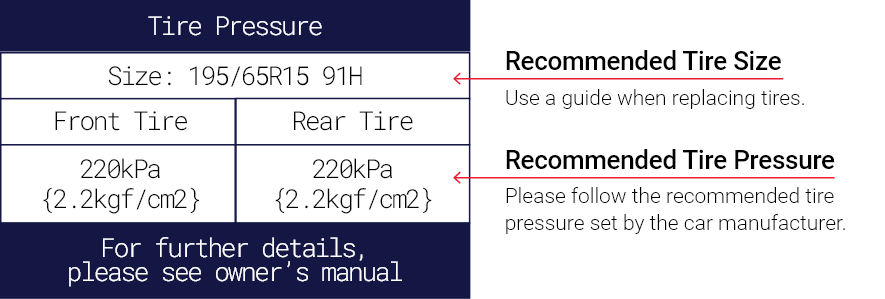
Please check the tire pressure when the tire is cooled to obtain a more accurate measurement. In other words, when the vehicle has been traveling for less than 2 km or parked for at least 3 hours.
Shallow Thread
Bald tires will skid on the road and be damaged by potholes. Groove depth should be at least 1.6 mm otherwise the tires must be replaced.
Tread Problems
Tread Wear Indicator (TWI) is a raised section molded into the grooves of a tire. When the tread is leveled with the TWI, the tires need to be replaced immediately.

Minor Problem
Check if the tread has been pierced by small stones, glass, metal, or other foreign objects and carefully clean the affected area. If you let these objects get embedded deeper, it may cause serious problems.
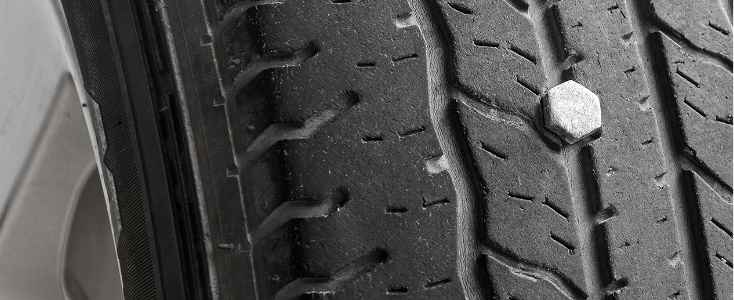
Solutions
1. If your car has a spare tire, please replace the damaged tire with the spare tire and take your car to the nearest Giti Professional Service Center.
2. Tread puncture diameter 6 mm or below can be repaired. Tread or sidewall puncture diameter greater than 6 mm and tread wear less than 1.6 mm cannot be repaired and are safety hazards.

Visual Tire Inspection:
Are there cuts or penetration on the tire casing?
Main Reason:
Tread is pierced by sharp objects or nails
Impact on Tire:
Safety hazard
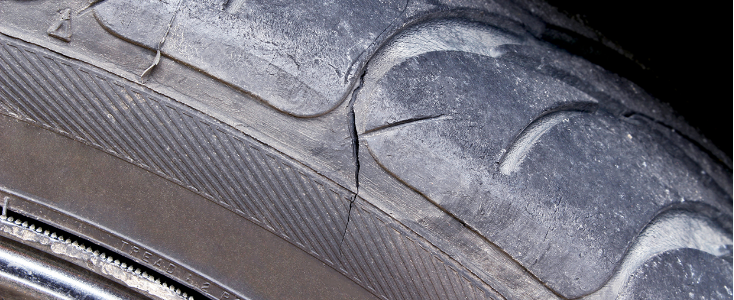
Check Tire Appearance:
Are there bulges on the tire casing?
Main Reason:
On unpaved roads, tires may bounce over deep holes or be impacted by foreign objects which leads to tire and rim deformation, causing a break in the sidewall ply. When combined with internal pressure, the break forms a bulge. Additionally, driving up a curb or parking results in the tire rubbing against objects which cause sidewall bulges.
Impact on Tire:
Safety hazard
Solutions:
1. For your safety, replace tires immediately
2. Tire bulge or air bubbles cannot be repaired
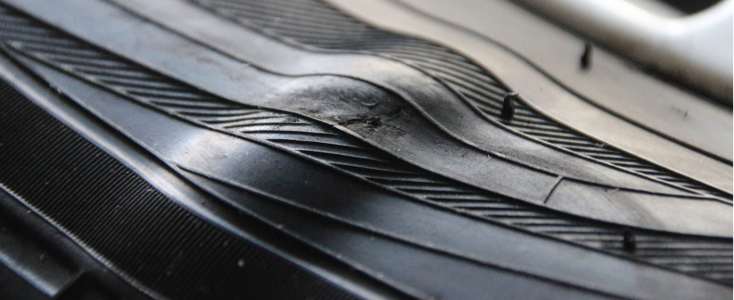
If tire casing is damaged, replace tires.
Slow Air Leak:
Tires will lose a small amount of air pressure every month. If tires need to be inflated every few days, please check the tires, rims, and valve. If necessary, go to a professional service center to repair or replace tires.
Valve Cap:
The valve cap prevents moisture and dust from entering into the tire. Please use them. If you replace tires, make sure to fit a new valve cap.
Using damaged tires is extremely dangerous!
Suspicious Conditions:
Please visit a professional service center for inspection. If tires appear to be damaged, do not use.
Improper Driving Leads to Tire Damage or Excessive Wear:
If vibration or other problems occur when driving and you suspect there is tire or vehicle damage, please slow down, drive carefully, leave the main road, park, and check the tire.
Tire Damage:
If you cannot see the tire damage, please visit a professional service center for inspection.
Tire pressure, including the spare tire, should be checked at least once a month or before driving long distance.
The pressure should be checked after the tire cools down (at least 3 hours after stopping).
Use a tire pressure gauge to check the tire pressure.
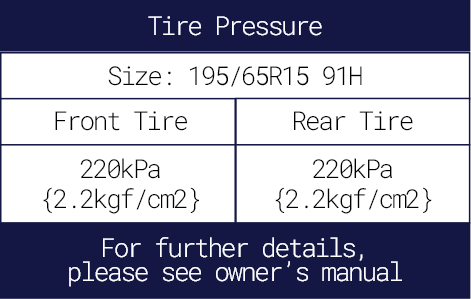

The recommended tire pressure for each vehicle is set by the car manufacturer and can be found in various areas of the vehicle such as: car owner’s manual, driver’s side door, and fuel filler door.
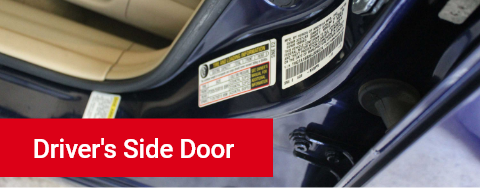
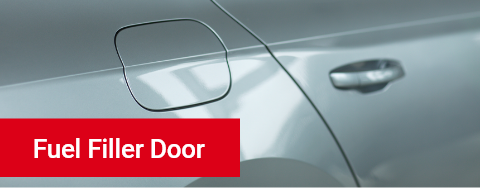
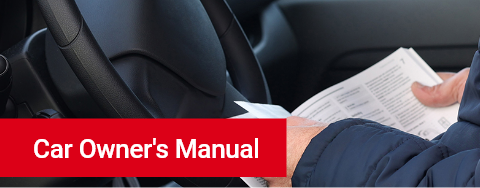
Proper tire pressure helps maintain normal fuel consumption and tire wear, optimizes tire life and performance, and effectively improves safety.
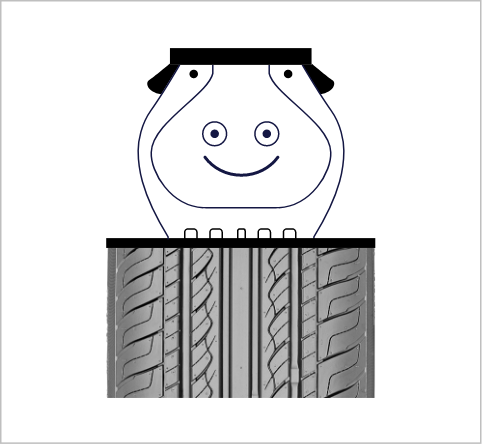
Proper Tire Pressure
Normal wear and tear with extended tire life.
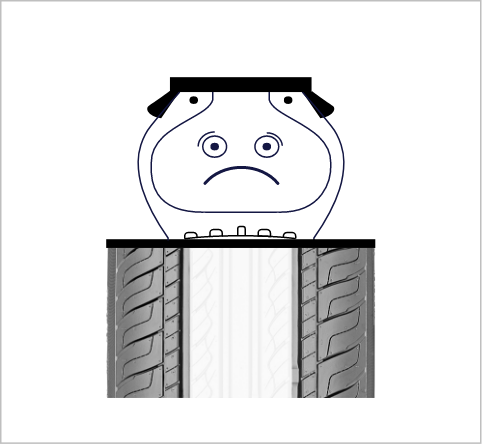
Low Tire Pressure
Causes uneven wear and excessive wear on tire shoulders.
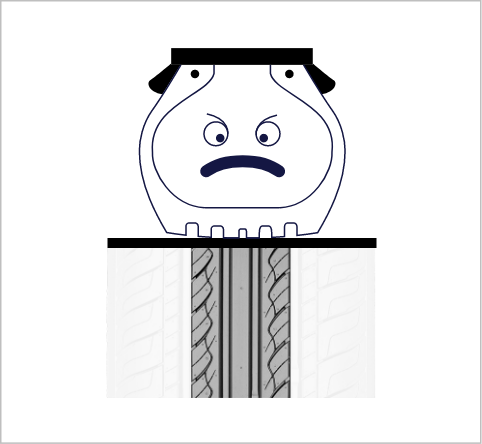
High Tire Pressure
Causes uneven wear and excessive wear in tread center.
What Is the Appropriate Tire Pressure for My Car?
The recommended tire pressure for each vehicle is set by the car manufacturer and can be found in various areas of the vehicle such as: car owner’s manual, driver’s side door,fuel filler door, and etc.
Vehicle load and tire pressure is interrelated.For larger loads,please increase the tire pressure.

Recommended tire pressure is set by car manufacturer. The tire pressure label can be found on the driver’s seat door.

Please check the tire pressure when the tire is cooled to obtain a more accurate measurement. In other words, when the vehicle has been traveling for less than 2 km or parked for at least 3 hours.
Never try to mount your own tires. Visit a Giti Professional Service Center when you need to mount tires.
If you attempt to mount tires, you run the risk of seriously injuring yourself as well as damaging the tires and rims.
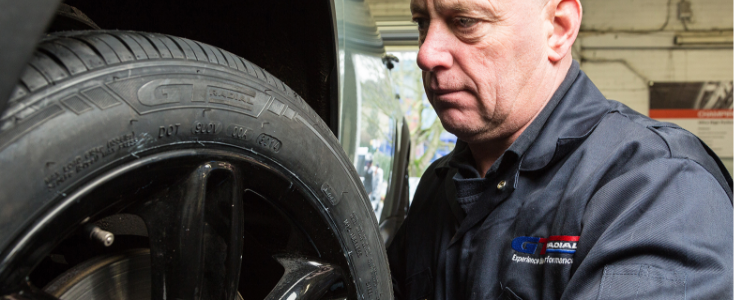
Proper tire rotation on a regular basis will uniformly wear the tire, extend tire life, and improve safety.
After traveling for 8,000-10,000 km, we recommend rotating tires at a service center. When rotating tires please keep in mind “4 Consistency” – same brand, size, pattern, and size because some vehicles have different front and rear specifications.
Tire Rotation Samples:
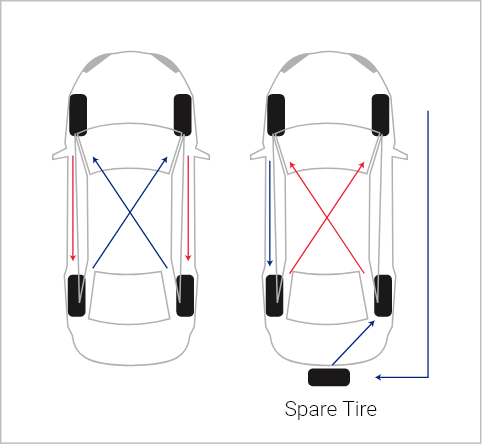
Front-Wheel Drive
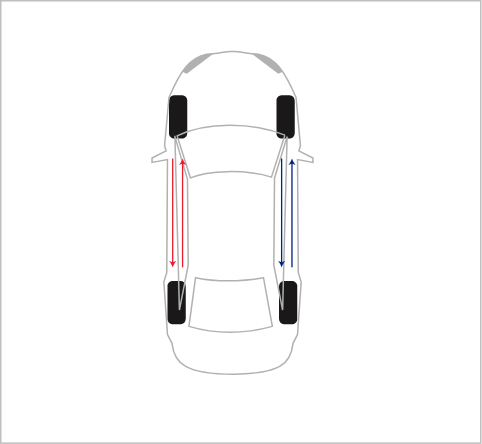
Directional Tire Rotation
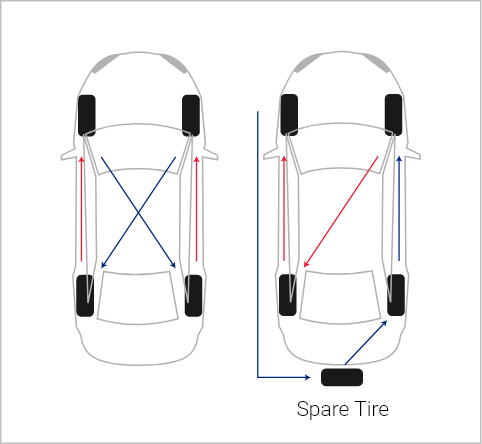
Rear-Wheel or Four-Wheel Drive
Tires will undergo frequency and speed adjustments at different intervals to keep the tire and vehicle rotation running straight and the load bearing direction perpendicular to the ground. Vehicle manufacturers designed different angles to handle a variety of road conditions and enhance vehicle performance. Overtime, these angles will suffer wear which leads to deformation while replacing suspension parts will cause a deviation from the set values, resulting in poor vehicle and tire performance. Therefore, proper wheel alignment can help correct and prevent these problems.
Effects of Improper Wheel Alignment:
- Affects Safety:
Poor high-speed stability and high-speed cornering ability causes displacement of gravity leading to vehicle skids - Increases Component Wear:
Vibration and shakes leads to vehicle component wear while incorrect angles causes rapid irregular tire wear - Poor Handling:
Steering is too heavy or too light - Driving Fatigue:
Vibration and shakes will decrease comfort level while constantly correcting the direction of the steering wheel increases driving fatigue - Increases Fuel Consumption:
Unsmooth driving causes large energy loss
In the Following Situations, Wheel Alignment Needs To Be Corrected:
- Steering wheel is not centered when driving straight.
- Vehicle pulls to the left or right when you take hands off of the steering wheel (Test on Open Road).
- Intense irregular wear.
- Unstable suspension.
- Steering wheel sways from side to side when driving straight.
- Vehicle tends to deviate when driving.
- Vehicle noise or strange sounds develop.
- After replacing suspension component.
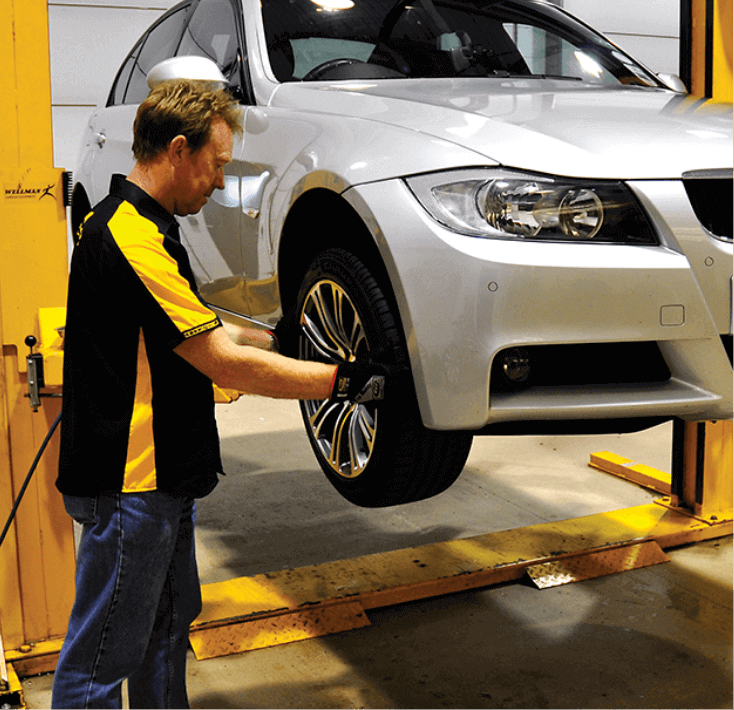
When tire and rim assemblies are unbalanced, it will cause wheel shimmy (wheel shakes from side to side) or wheel tramp (wheel hops up and down). Therefore, it is important to achieve static and dynamic balance.
Steps to Balancing:
- Match tire reference dots with rim marks or valve cap
- Use professional balancing equipment to balance tires
- If balancing weight exceeds the limit, reposition the tire and rim by adjusting 180° or 90 °
- If balancing weight still exceeds the limit, check if there is a rim deformation
Benefits of Balancing:
- Prevents tire vibration and tire shimmy
- Does not affect comfort level
- Avoid irregular tire wear
- Avoid irregular vehicle suspension system wear
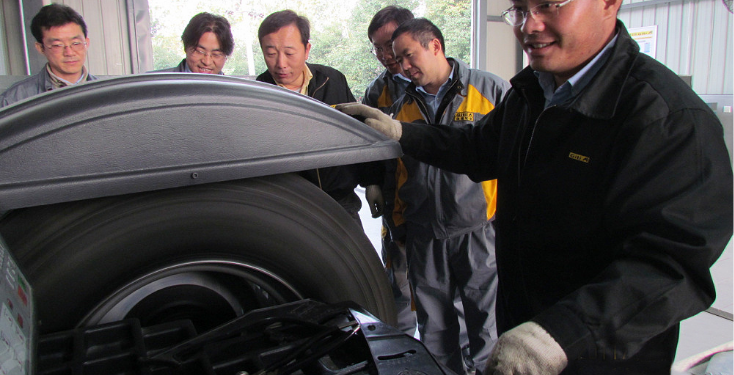
Under normal circumstances, tires can meet the vehicle’s designed mileage but a number of factors impact tire mileage such as: vehicle applications, tire maintenance, road conditions, weather conditions, driving habits, and etc.
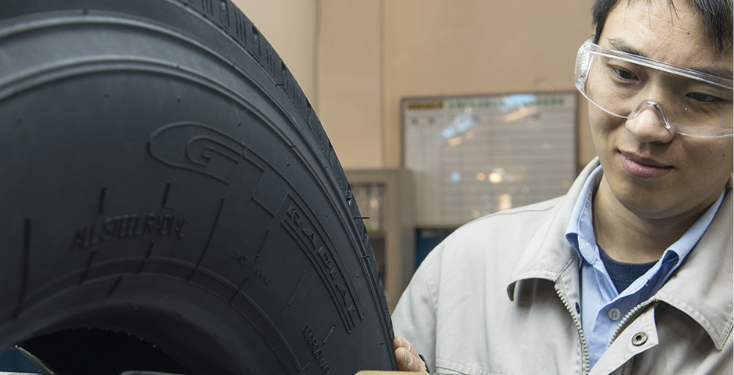
Avoid used tires.
You never know what damages the tire suffered. If you use a damaged tire, it may cause accidents.
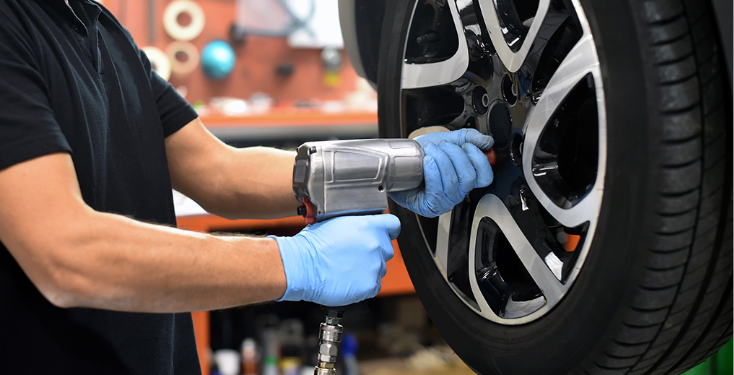
The answer is, Yes.
Tips That Help Increase Tire Life:
- Do not speed. High speeds will generate excessive heat, which increases the rate of tire wear.
- Avoid fast turns on curves and corners. Avoid quick starts and panic stops.
- Do not ride on the edge of the pavement or drive over curbs, potholes, or other obstructions.

Main Causes:
Many factors such as the engine, steering system, suspension system, and tire may cause the vehicle to shake. We recommend you go to a professional service station for inspection.
Impact on Tires:
Causes improper tire wear and affects tire life.
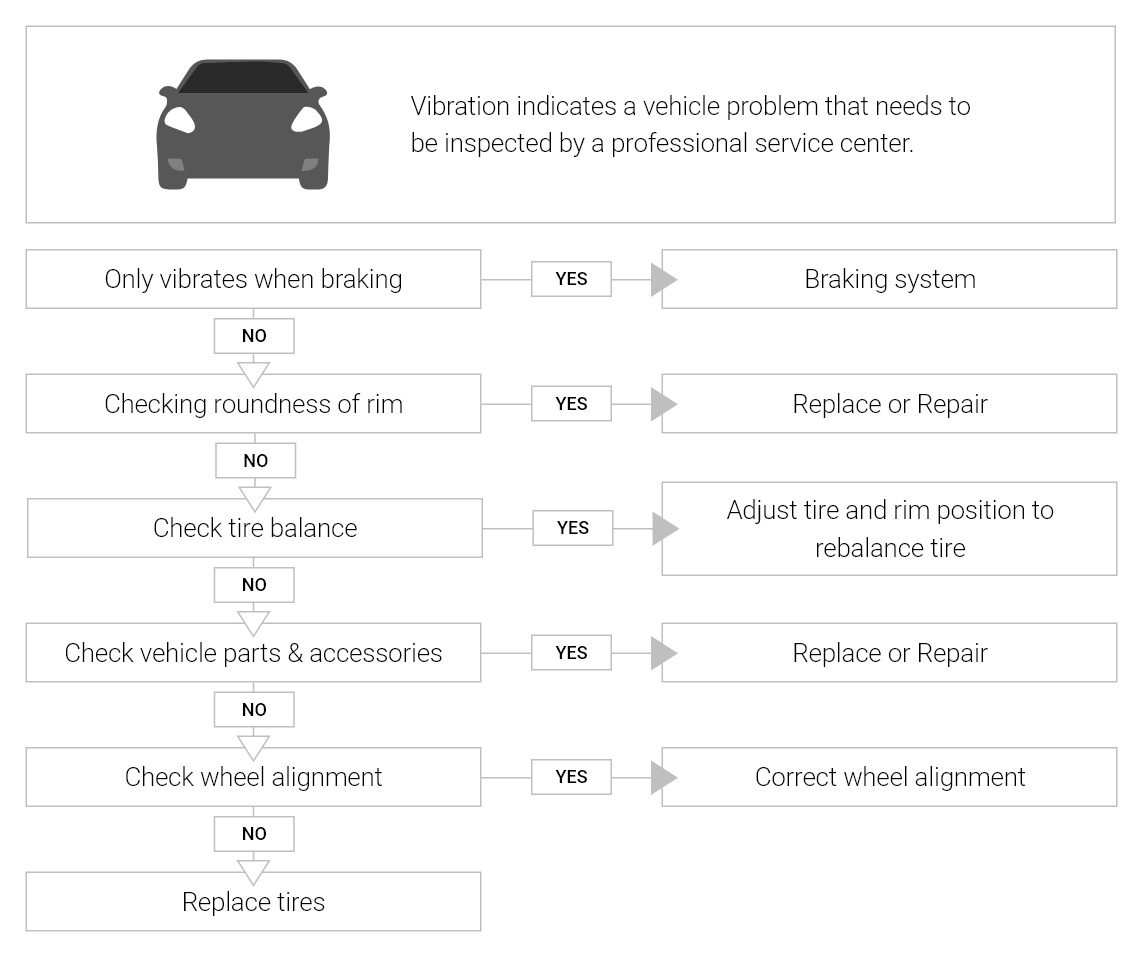
Causes:
Poor braking system, positioning, suspension system, transmission, tires, and etc.
Impact on Tires:
Causes improper tire wear and affects tire life.
Solution:
Visit a professional service center for inspection.
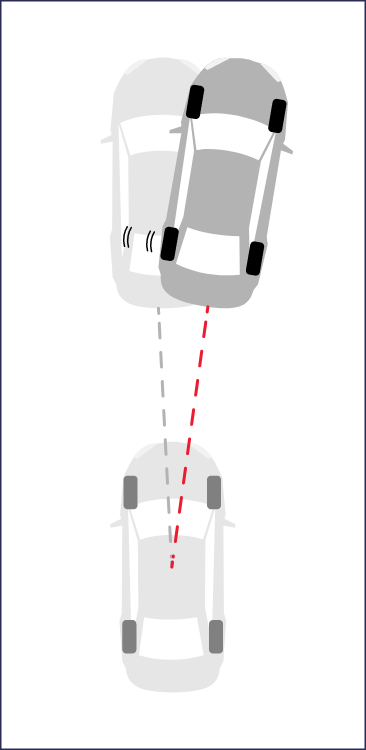
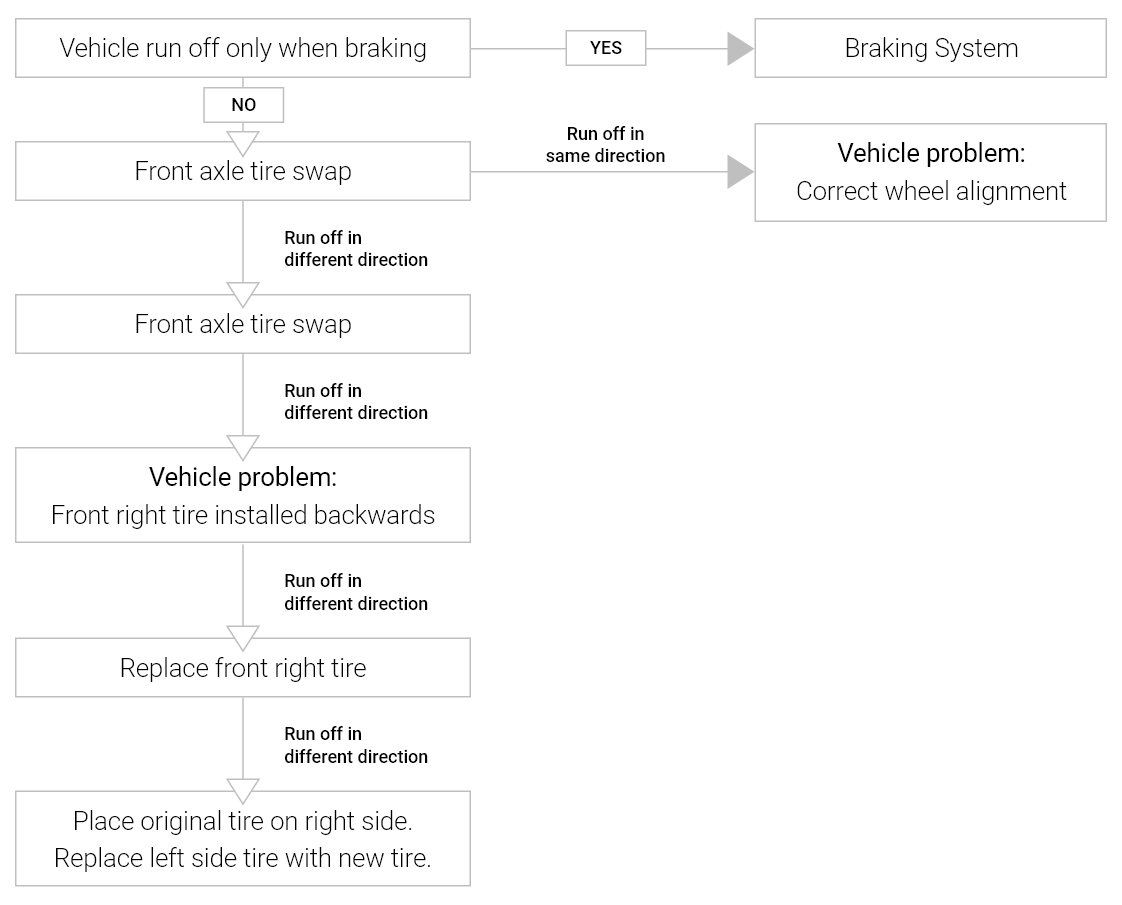
When freeing a vehicle from sand, mud, snow, gravel, ice, snow, or wet surfaces, excessive wheel spin can result in tire failure and cause personal injury or vehicle damage.
Do not exceed 55 km/h, as indicated on the speedometer.

Never stand near or behind a vehicle that is attempting to free itself from a ditch because the tires will be spinning at a high speed.
TIRE WEAR
Tire wear and damage are serious issues that can cause your vehicle trouble. Find out how to recognize potential problems and take care of them if they do occur.
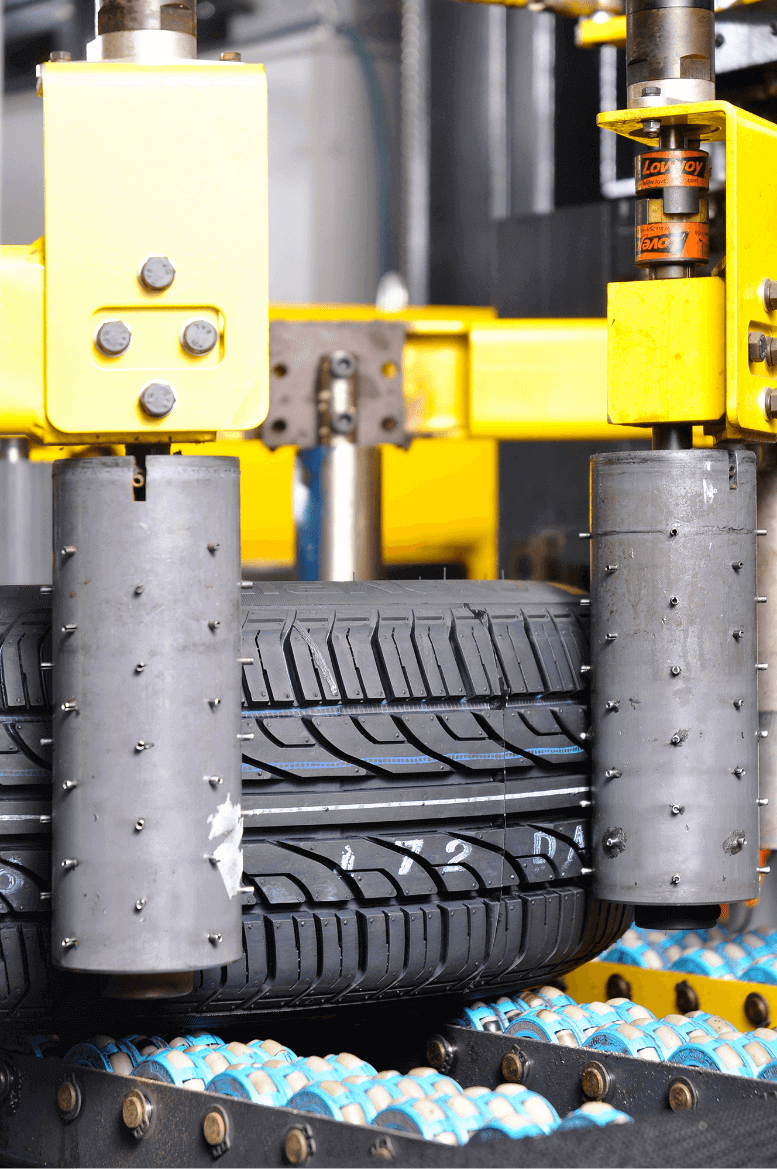
Causes:
- Over inflation.
- Rim width is too narrow (tires and rims do not fit each other).
- Rear wheel drive vehicles centralize load bearing on rear tires.
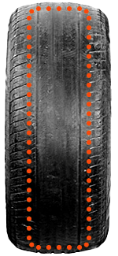
Impact on Tires:
- Tread center wears quicker than shoulders, reducing tire life.
- Enhances tire rigidity but decreases cut resistance and comfort level.
- Likely to cause sudden tire blowouts due to foreign impact.
- Increases braking distance, weakens grip, decreases safety.
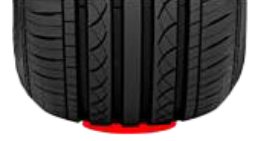
Solutions:
Deflate the Tire: use a tire pressure gauge to deflate the tire until the pressure reaches the recommended level set by the vehicle manufacturer. The recommended tire pressure can be found in various areas of the vehicle such as: car owner’s manual, driver’s side door, and fuel filler door.
The pressure should be checked after the tire cools down (at least 3 hours after stopping or traveling within 2 km).
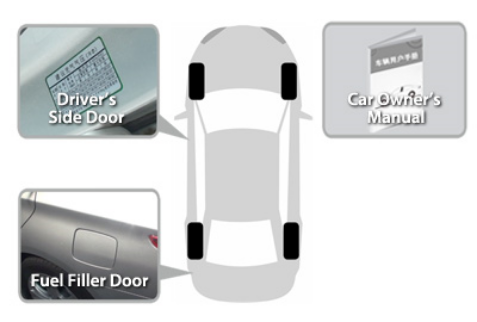
What Causes Rapid Shoulder Wear on One Side?
Causes:
- Incorrect camber angle or toe.
- In order to achieve maximum tire life, please check the suspension system and perform proper wheel alignment.
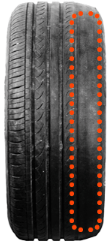
Causes:
- Under inflated tires or overloading.
- Frequent braking or sharp turns.
- Tire and rim do not match or rim is too wide.
Impact on Tires:
- Inner and outer shoulder wears quickly, reducing tire life.
- Leads to higher tire temperature, reduces tire durability, and causes accidents.
- Increases rolling resistance and fuel consumption.
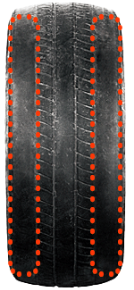
Under inflated tires – tire shoulder bears most of the load.

Solutions:
- Inflating to the proper tire pressure (measured with a tire pressure gauge). The recommended tire pressure can be found in various areas of the vehicle such as: car owner’s manual, driver’s side door, and fuel filler door.
- Make sure tire and rim fit each other.
- Good driving habits, avoid abrupt stops and acceleration.
The pressure should be checked after the tire cools down (at least 3 hours after stopping or traveling within 2 km).

What Causes Irregular Tread Wear?
Causes:
- Vehicle anti-lock braking system (ABS) fails
- Brake or tire lock
- Loose bearings or components
- Improper wheel balancing
- Deformed or off centered rims
- Chemical contamination
Impact on Tires:
- Affects Tire Life
Solutions:
- Please perform tire balancing and wheel alignment checks.
- Please perform suspension or steering system checks.
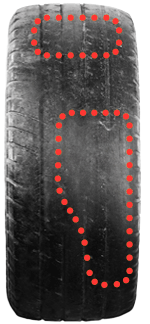
Main Causes:
- Poor vehicle suspension system will cause the tire surface to appear uneven and rough. In severe cases, the tread pattern will appear feathery.
Common Causes:
- Incorrect toe setting
- Poor vehicle suspension system
Solutions:
- Please perform tire balancing and wheel alignment checks.
- Please perform suspension or steering system checks.
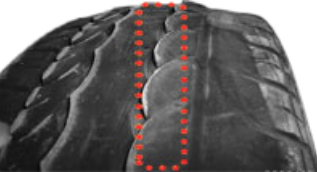
Results in Rapid Wear on Front Axle Tires:
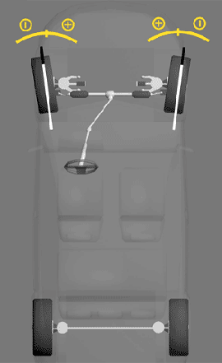
Positive Camber
Large positive camber will cause feathering and outer shoulder wear.
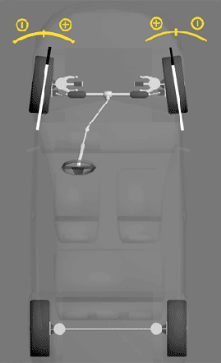
Negative Camber
Large negative camber will cause feathering and inner shoulder wear.
Impact on Tires:
- Affects tire life.
Solutions:
- Vehicle needs to perform wheel alignment and suspension system checks.
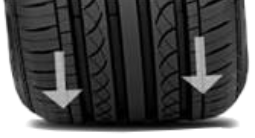
Factors That Affect Tire Life:
- Driving habits and styles
- Tires paired with correct vehicle model
- Different road surfaces
- Vehicle and tire maintenance
- Improper wheel alignment
- Braking system error
Impact on Tires:
- Affects tire life.
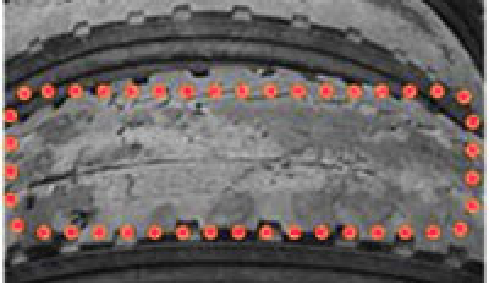
Solutions:
- To achieve maximum tire life, please check the suspension system and perform proper wheel alignment.
Causes:
- Driving with insufficient air pressure for long periods
- Tread cuts, punctures, or improper repairs
When tread separation occurs, replace tires immediately.
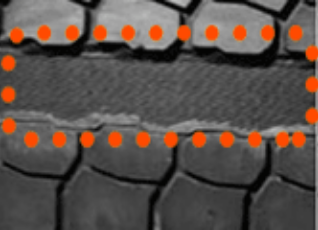
What Is the Appropriate Tire Pressure for My Car?
The recommended tire pressure for each vehicle is set by the car manufacturer and can be found in various areas of the vehicle such as: car owner’s manual, driver’s side door, fuel filler door, and etc.
Vehicle load and tire pressure is interrelated. For larger loads, please increase the tire pressure.

Recommended tire pressure is set by car manufacturer. The tire pressure label can be found on the driver’s seat door.

Please check the tire pressure when the tire is cooled to obtain a more accurate measurement. In other words, when the vehicle has been traveling for less than 2 km or parked for at least 3 hours.
When the tire crown exposes steel cords, the tires should be replaced immediately.
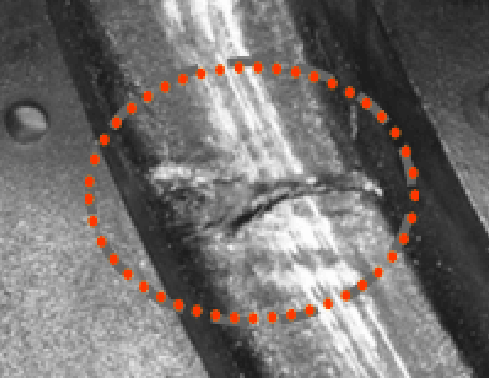
Causes:
- Internal tire structural damage.
When driving, the tire shoulder or sidewall is impacted by foreign objects (e.g. potholes and curbs) which causes the tire casing cord to break. The internal tire pressure combined with the weakness in the sidewall causes bulges to form at the area of weakness.
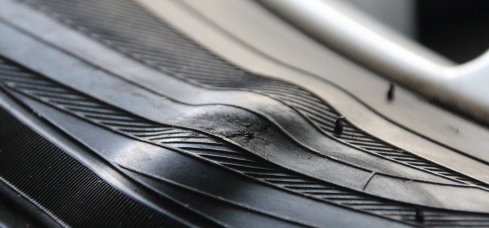
How to Prevent Tire Bulges:
- When mounting tires, visit a professional tire shop that uses professional equipment and procedures
- Avoid driving on poor road conditions for long periods and reduce speed on poor roads to help minimize the impact of foreign objects (e.g. potholes)
- Try not to hit obstacles when going on the curb or parking
- Develop good tire maintenance practices such as performing regular tire pressure checks to make sure proper pressure is used
Causes:
- Scratched by sharp objects (curb, stones, metal fragments, and etc.)
Solutions:
- Avoid road obstructions
- Go to the nearest service center to repair tire scratches and avoid further damage
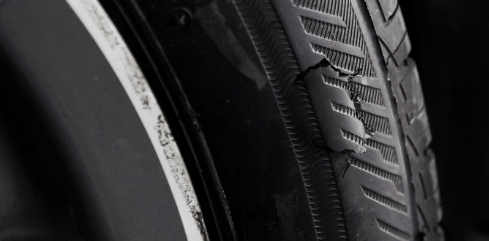
Prolonged exposure to direct sunlight, high temperature, heat, and generators will deteriorate tires. At the same time, oil, gasoline, and other substances will also cause deterioration.
Parking the vehicle outside for long periods, hinders anti-aging properties from being released.
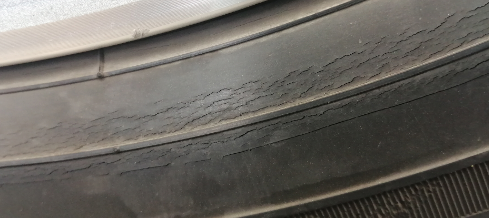
Causes:
- When traveling on the road, sharp objects impact the tire crown and cause the steel belt to break and corrode leading to a deformed tire casing and abnormal tread wear.
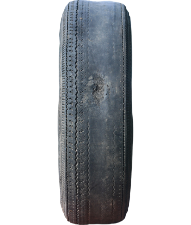
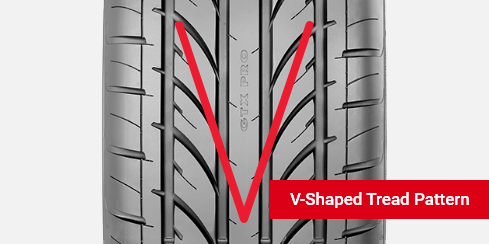
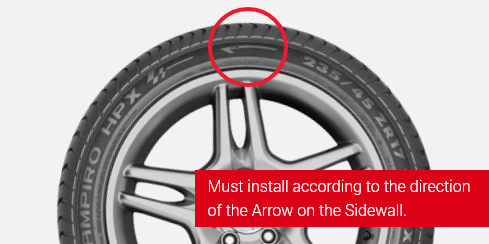
Directional Tread Pattern:
- Usually has a V-shaped pattern and sidewalls are marked with tire rotation direction.
- Must be mounted in the same rotation direction marked on the sidewalls.
- If all four tires are the same size, directional tires can only be rotated vertically (front-back).
Symmetrical Tread Pattern:
- Usually has a continuous rib or block design with the same features on both inner and outer tread.
- Wavy pattern.
- If all four tires are the same size, symmetrical tires can be rotated diagonally, horizontally, or vertically.
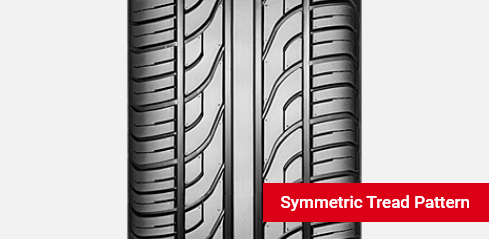
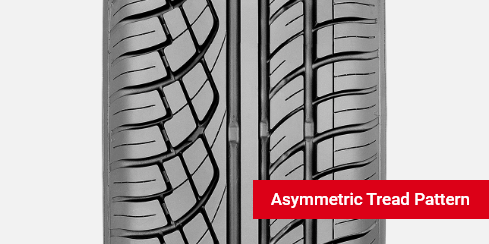
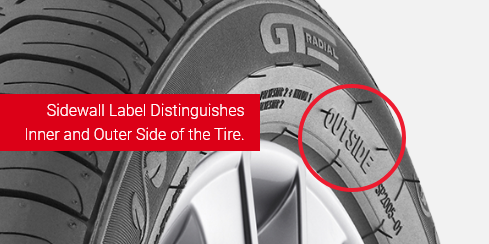
Asymmetric Tread Pattern:
- Have unique patterns on both sides of the tread. Outer tread usually has larger grooves for better water dispersion and increased wet handling while inner tread usually has smaller grooves to increase contact area and improve grip.
- Sidewall markings identifying inner and outer side of tire.
- If all four tires are the same size, asymmetric tires can be rotated the same way as symmetrical tires with care given to the inner and outer tire markings.
Causes:
- Tire reaches wear limit and must be replaced when the tread depth is 1.6 mm or leveled with the TWI (Tread Wear Indicator).
Solutions:
- Take your vehicle to the nearest Giti Professional Service Center for a tread depth inspection.
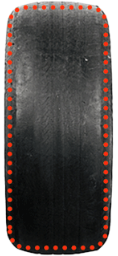
WINTER TIRE CARE
Winter driving presents its own unique set of driving challenges. Learn more about these tires and how they can benefit you in cold, snowy, and icy conditions.
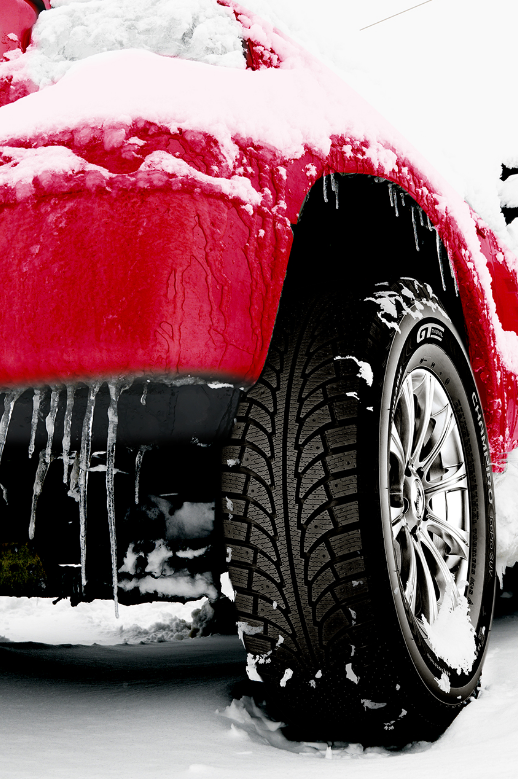
When average daily temperatures are at or below 7°C, a switch to winter tires is strongly recommended.
At below 7°C
Ordinary Tires will Harden and Flexibilty is Reduced.
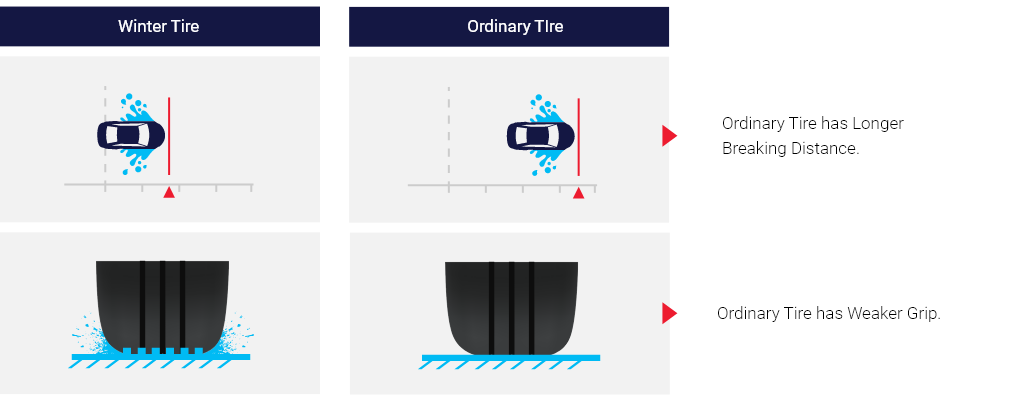
Winter tires are designed using a special rubber compound formula and pattern. These tires optimize safety on winter roads and ensure grip capabilities are still effective at temperatures below 7°C.
Solution:
Take your vehicle to the nearest Giti Professional Service Center for a tread depth inspection.
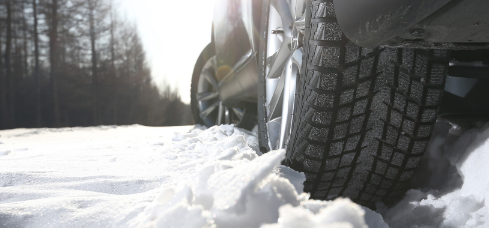
Winter Tire Mistakes
MISTAKE 1
I mainly drive in urban areas that barely snow so I do not need winter tires.
Fact:
- Generally speaking, when the temperature drops below 7°C, summer tires’ performance is weakened resulting in longer braking distance and poor handling.
- During the winter, after it rains a thin invisible ice layer will form on the road surface which weakens summer tire performance, causing handling malfunctions and longer braking distance.
MISTAKE 2
If you buy only two winter tires, they should be mounted on the driving wheel to ensure sufficient driving power is produced (e.g. for front-wheel drive vehicles, tires should be mounted on the front wheels).
Fact:
- All four winter tires need to be replaced at the same time to ensure superior braking performance on winter roads. If you only mount two tires, they may cause uneven gripping which leads to vehicle spins.
MISTAKE 3
When stopping on icy or snowy roads, lots of pressure should be applied on the brakes.
Fact:
- Firstly, you will need to know if your car is equipped with an anti-lock braking system (ABS). You can check the vehicle owner’s manual for vehicle related information.
- Firstly, you will need to know if your car is equipped with an anti-lock braking system (ABS). You can check the vehicle owner’s manual for vehicle related information.
- If your vehicle is not equipped with ABS, you must press the brakes all the way when breaking on wet roads. Do not gently step on the brakes as this will lead to wheel lockup.
Winter road safety requires proper equipment, experienced skills, and rational approaches such as keeping a slow and steady speed (sometimes even below the minimum speed limit).
Winter tires are created using a special rubber tread formula that improves grip, traction, and braking performance at low temperatures to enhance the safety on icy and snowy roads. The tread compound can be compared to chewing gum. At temperatures below 7°C, the tread will start to harden.
At below 7°C
Ordinary Tires will Harden and Flexibilty is Reduced.

Precautions for Driving on Icy and Snowy Roads
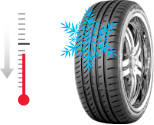
When driving on icy and snowy roads in low temperatures, please change to winter tires with a tread depth of more that 50%.

Need to increase vehicle turning radius due to a lack of grip on the freezing road surface. Turning too small will cause the vehicle to lose grip.

Accelerate gently because winter tires tend to freeze and rapid acceleration will cause skids.
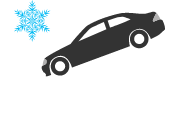
When driving on ramps, speed must be controlled. Neutral gear is prohibited when driving downhill.

Avoid using the emergency brake. Use a lower gear to reduce the speed.
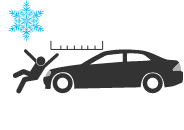
When driving on icy and snowy roads, keep a distance from pedestrians or bicycles to prevent accidents.
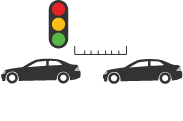
When encountering a red light or obstructions, please slow down and keep safe distance between cars.

Select dry parking locations, away from wet potholes to avoid tires from hardening and lose its physical properties.
Winter road safety requires proper equipment, experienced skills, and rational approaches such as keeping a slow and steady speed (sometimes even below the minimum speed limit)
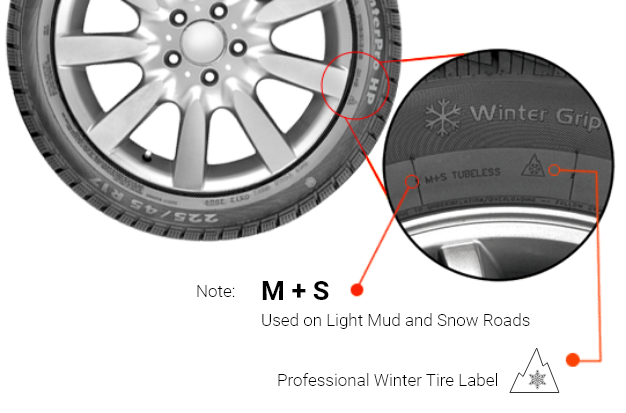
Winter road safety requires proper equipment, experienced skills, and rational approaches such as keeping a slow and steady speed (sometimes even below the minimum speed limit)
Winter tires can be mounted on four-wheel drive vehicles and the rear axle of a rear wheel drive vehicle to enhance stability.
If winter tires are only mounted on the front axle, handling capabilities may be reduced.
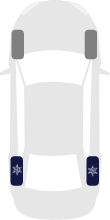
At below 7°C
Ordinary Tires will Harden and Flexibilty is Reduced.

Using winter tires with a lower speed rating than the original equipment tire is common practice and permitted.
If a lower speed rating is selected, the maximum vehicle speed is limited to the lower speed rating.

Here is no legal obligation to mount 4 tires of the same brand on a given vehicle.
However, in order to optimize tire performance, we recommend mounting 4 identical tires (same brand, tire model, load index, and speed index) on a vehicle.
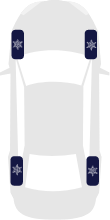
The answer is, No.
Winter tire tread compounds are as durable as the ones used in summer tires. Winter tires are specifically designed to achieve maximum efficiency in winter conditions.
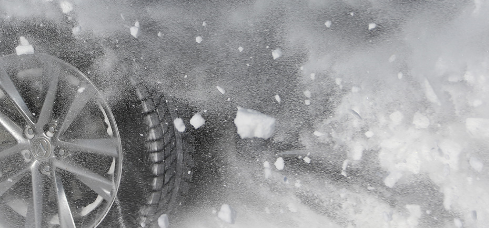
The answer is, No.
If the winter and summer tires are the same size, it is not necessary to replace the rims.
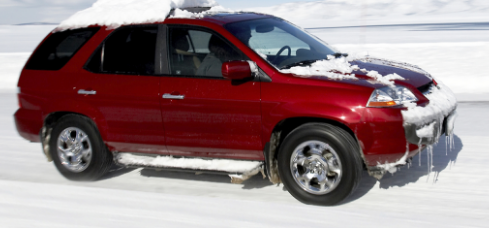
The answer is, Yes.
On winter roads, ordinary tires have a longer braking distance.
At below 7°C
Ordinary Tires will Harden and Flexibilty is Reduced.

The answer is, No.
Tire pressure is essential for safety, performance, tire life, tread wear, handling, fuel consumption, and etc.
Underinflated tires increase friction causing a rise in tire temperature which leads to potential accidents.
Overinflated tires are firmer making them prone to damage from potholes and other road hazards.
Remember: Tires are your only contact with the road.
When winter tire tread depth is worn half way, it is time to replace the tire.
Unlike ordinary tires that need to be replaced when the tread depth is 1.6 mm.


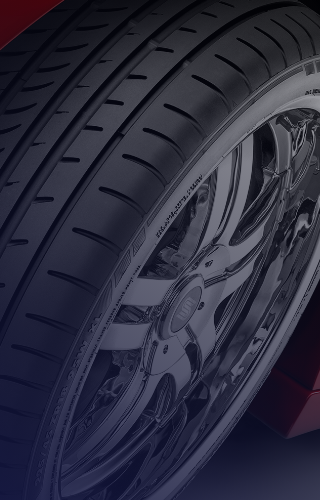
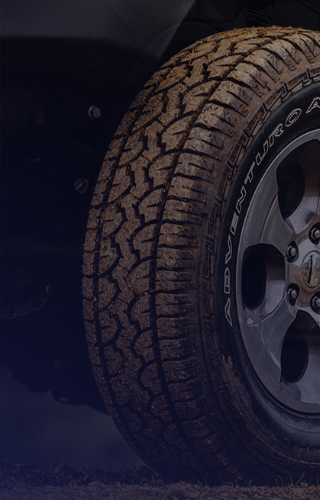
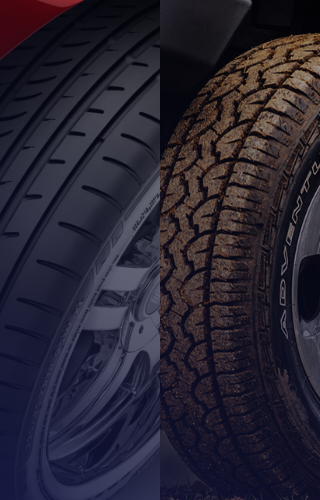
 Extreme Grip
Extreme Grip Wet
Wet Dry
Dry Handling
Handling Sports
Sports
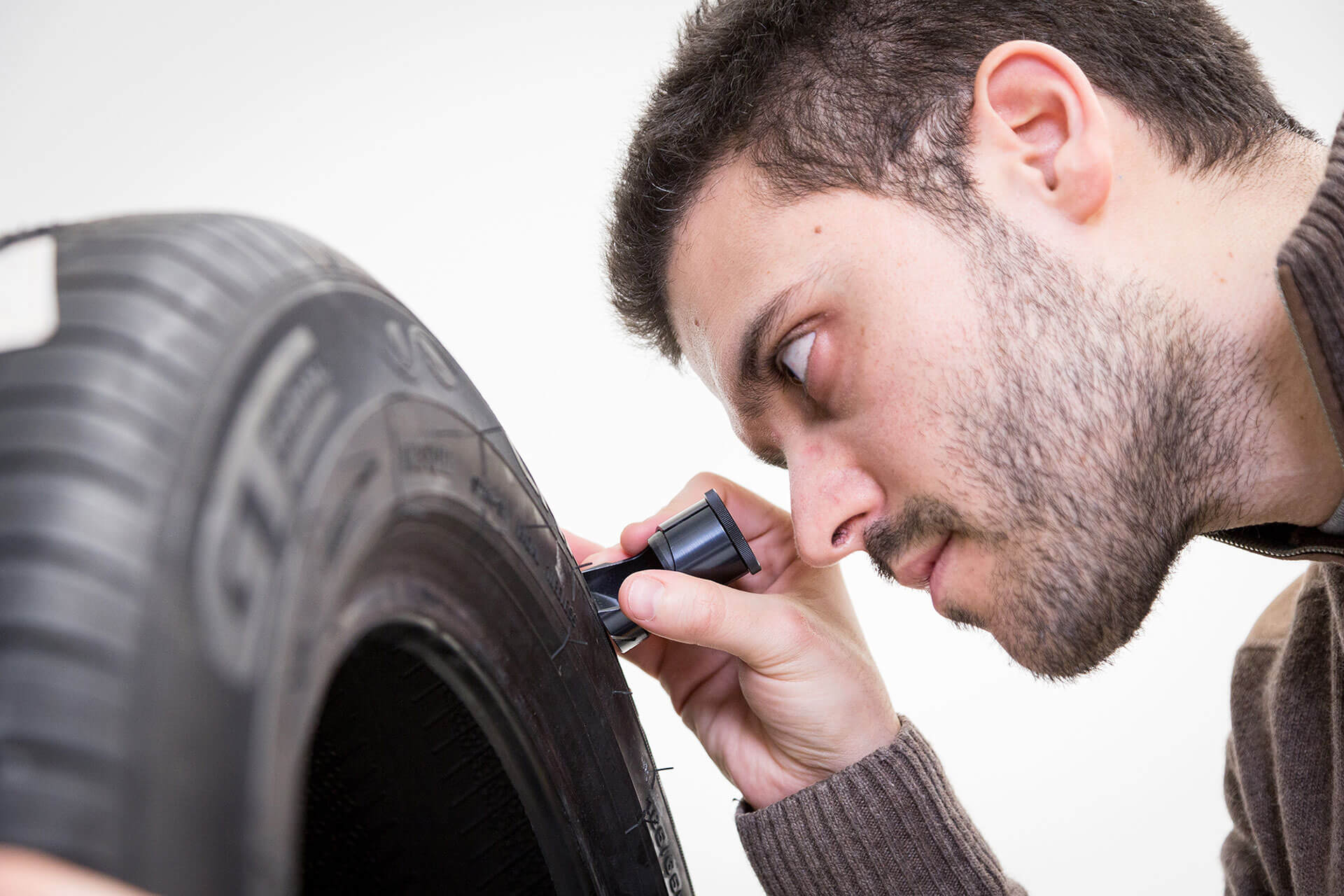

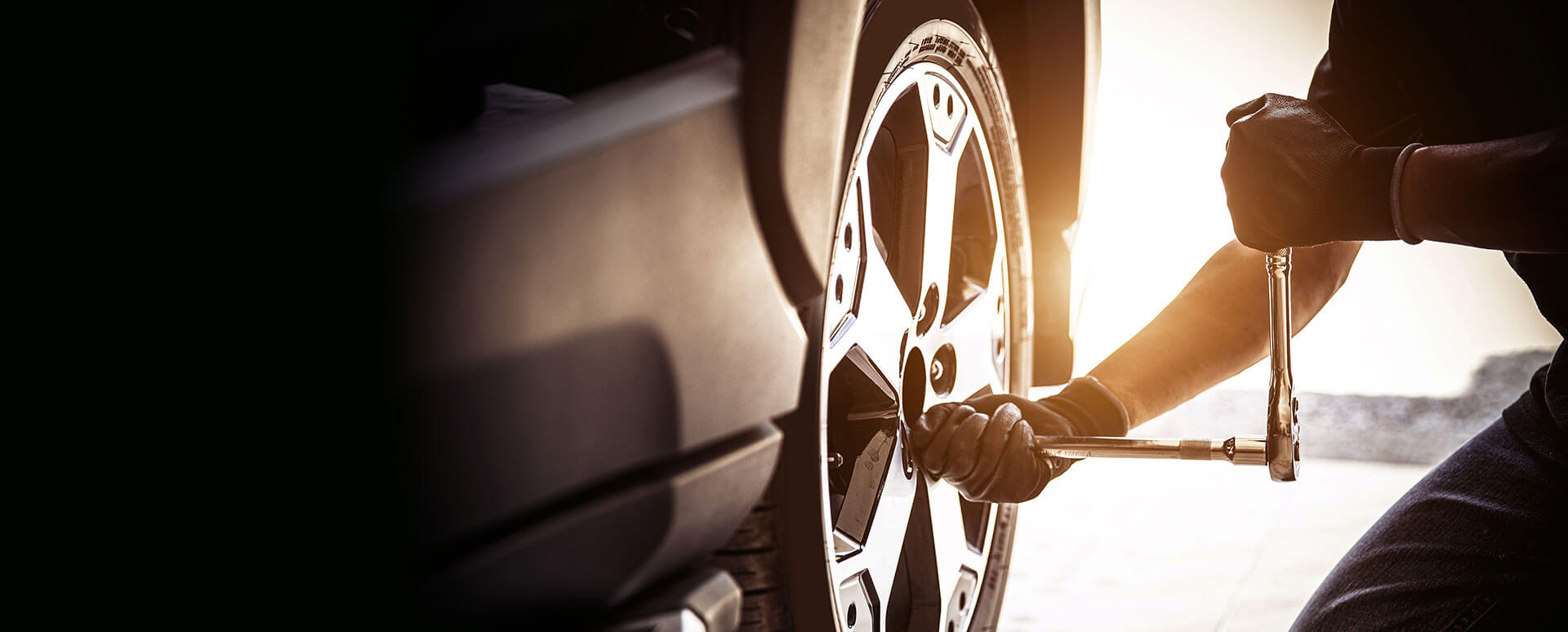
 The United
States
The United
States